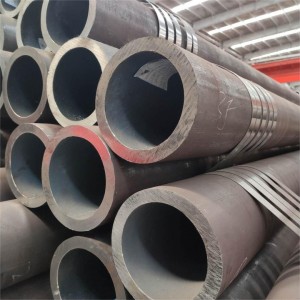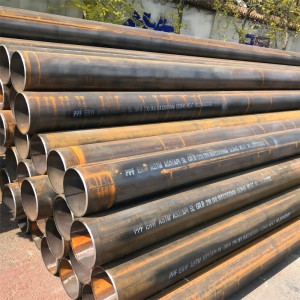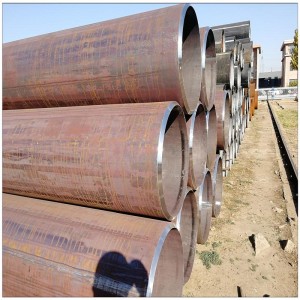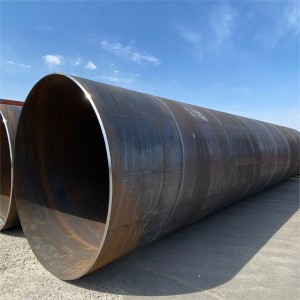SMLS, ERW, LSAW, and SSAW are some of the common production methods used in the production of steel pipes.
Appearance of SMLS, ERW, LSAW, and SSAW
Key Differences Between SMLS, ERW, LSAW, and SSAW
| Abbreviations | SMLS | ERW | LSAW (SAWL) |
SSAW (HSAW, SAWH) |
| Name | seamless | Electric Resistance Welded | Longitudinal Submerged Arc Welding | Spiral Submerged Arc Welding |
| Raw Material | steel billet | steel coil | steel plate | steel coil |
| Technique | Hot-rolled or cold-drawn | resistance welding | submerged arc welding | submerged arc welding |
| Appearance | No weld | Longitudinal weld seam, weld seam not visible | Longitudinal weld seam | Spiral weld seam |
| Common Outside Diameter(OD) |
13.1-660 mm | 20-660 mm | 350-1500 mm | 200-3500 mm |
| Common Wall Thickness(WT) |
2-100 mm | 2-20 mm | 8-80 mm | 5-25 mm |
| Prices | highest | cheaply | high | cheaply |
| Specificities | Small diameter thick wall steel pipe | Small diameter thin wall steel pipe | Large diameter thick wall steel pipe | Extra large diameter steel pipe |
| Appliance | Petrochemical, boiler manufacturing, geological drilling, and other industries | For low-pressure fluid transfer, such as water, gas, air, and steam piping | Mainly used in long-distance pipelines for the transmission of oil, natural gas, or water | Mainly used for low-pressure fluid transportation, such as water and gas pipelines, as well as for building structures and bridge elements |
Understanding the differences between these steel pipes can help ensure that the material best suited to the project's needs is selected to optimize performance, cost, and durability. Each type of steel pipe has its unique advantages and limitations, and selection needs to be based on specific project needs and conditions.
SMLS, ERW, LSAW, and SSAW Processes in a Nutshell
SMLS (Seamless Steel Pipe) Process
Selection: High-quality steel billet as raw material.
Heating: Heat the billet to a suitable rolling temperature.
Perforation: The heated billet is processed into a tube billet in a perforating machine.
Rolling/Stretching: Further processing or cold drawing through the tube mill to obtain the required size and wall thickness.
Cutting/Cooling: Cut to the required length and cool.
ERW (Electric Resistance Welded Steel Pipe) process
Selection: Coil (steel coil) is used as raw material.
Forming: The steel coil is unrolled and formed into a tube by a forming machine.
Welding: High-frequency current is used to heat the edges of the opening through the welding electrode, causing localized melting of the metal, and welding is achieved by pressure.
Shearing: The welded tube is sheared to the required length.
LSAW (Longitudinal Submerged Arc Welded Steel Pipe) process
Selection: Steel plate is used as raw material.
Pre-bending: Pre-bending both sides of the steel plate.
Forming: Roll the steel plate into a tube.
Welding: Butt welding along the longitudinal direction of the tube using submerged arc welding.
Expanding/straightening: Ensuring the accuracy and roundness of the tube diameter by mechanical expanding or straightening machines.
Cutting: Cut to the required length.
SSAW (Spiral Submerged Arc Welded Steel Pipe) process
Selection: Coil (steel coil) is used as raw material.
Forming: The steel coil is rolled into a spiral pipe shape in a forming machine.
Welding: spiral double-sided automatic submerged arc welding on the outside and inside of the tube at the same time.
Cutting: The welded tube is cut to the required length.
Common Standards
Specific implementation standards will vary depending on the manufacturer, the application requirements, and the regulations of the region in which it is located. Manufacturers should provide appropriate certifications to demonstrate that their products comply with specific standards.
How to choose the type of steel pipe
Application Scenarios
Determine the use environment and load-bearing requirements of the steel pipe, such as the conveying medium, pressure rating, and temperature conditions.
Dimensional specifications
Include pipe diameter, wall thickness, and length. Different types of steel pipe vary in size range and wall thickness, which are suitable for different application requirements.
Materials and grades
Select the appropriate grade of steel based on the chemical nature of the medium being conveyed and the environmental conditions.
Manufacturing standards
Ensure that the selected steel pipe meets the relevant standards, e.g. API 5L, ASTM series, etc.
Economy
Considering cost-effectiveness, ERW and SSAW are generally less expensive, while SMLS and LSAW offer higher performance in certain demanding applications.
Reliability and Durability
Choose a reputable manufacturer to ensure the quality and reliability of your pipe.
About Us
Discover unparalleled durability and performance with our top-grade welded carbon steel pipes, expertly crafted in China. As a trusted supplier and seamless steel pipe stockist, we offer an extensive range of robust steel pipe solutions tailored to meet your exact needs. Choose quality, precision, and reliability for your next project—choose us for your steel pipe requirements.
tags:smls, erw,lsaw,ssaw,steelpipe, suppliers, manufacturers, factories, stockists, companies, wholesale, buy, price, quotation, bulk, for sale, cost.
Post time: Apr-07-2024




